| Listing 1 - 10 of 187 | << page >> |
Sort by
|
Periodical
ISSN: 24448672 Year: 2016 Publisher: [Barcelona] : [Lisbon?] : Elsevier España, S.L.U., Wolters Kluwer Health, Inc. on behalf of PBJ-Associação Porto Biomedical/Porto Biomedical Society
Abstract | Keywords | Export | Availability | Bookmark
 Loading...
Loading...Choose an application
- Reference Manager
- EndNote
- RefWorks (Direct export to RefWorks)
Biology --- Research. --- Mathematical models. --- Biologie --- Medicine --- Biomedical Research --- Recherche. --- Modèles mathématiques.
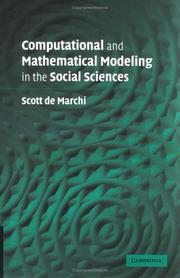
ISBN: 9780521853620 9780521619134 9780511510588 9780511345180 0511345186 0511510586 0521853621 0521853621 0521619130 9781139131421 1139131427 0521619130 1107154804 1281108510 9786611108519 0511344848 0511344457 0511344066 Year: 2005 Publisher: Cambridge Cambridge University Press
Abstract | Keywords | Export | Availability | Bookmark
 Loading...
Loading...Choose an application
- Reference Manager
- EndNote
- RefWorks (Direct export to RefWorks)
Mathematical models in the social sciences have become increasingly sophisticated and widespread in the last decade. This period has also seen many critiques, most lamenting the sacrifices incurred in pursuit of mathematical rigor. If, as critics argue, our ability to understand the world has not improved during the mathematization of the social sciences, we might want to adopt a different paradigm. This book examines the three main fields of mathematical modeling - game theory, statistics, and computational methods - and proposes a new framework for modeling. Unlike previous treatments which view each field separately, the treatment provides a framework that spans and incorporates the different methodological approaches. The goal is to arrive at a new vision of modeling that allows researchers to solve more complex problems in the social sciences. Additionally, a special emphasis is placed upon the role of computational modeling in the social sciences.
Social sciences --- Sciences sociales --- Mathematical models. --- Modèles mathématiques --- Social Sciences --- Political Science
Book
ISBN: 9780521863940 0521863945 9781139033756 9780521682527 9781139516556 1139516558 9781139518406 1139518402 1139033751 9781139514903 0521682525 1107225787 1280775076 9786613685469 1139517473 1139514903 1139513974 9781107225787 9781280775079 6613685461 9781139517478 9781139513975 Year: 2012 Publisher: Cambridge Cambridge University Press
Abstract | Keywords | Export | Availability | Bookmark
 Loading...
Loading...Choose an application
- Reference Manager
- EndNote
- RefWorks (Direct export to RefWorks)
Knowledge of risk models and the assessment of risk is a fundamental part of the training of actuaries and all who are involved in financial, pensions and insurance mathematics. This book provides students and others with a firm foundation in a wide range of statistical and probabilistic methods for the modelling of risk, including short-term risk modelling, model-based pricing, risk-sharing, ruin theory and credibility. It covers much of the international syllabuses for professional actuarial examinations in risk models, but goes into further depth, with worked examples, exercises and detailed case studies. The authors also use the statistical package R to demonstrate how simple code and functions can be used profitably in an actuarial context. The authors' engaging and pragmatic approach, balancing rigour and intuition and developed over many years of teaching the subject, makes this book ideal for self-study or for students taking courses in risk modelling.
Risk (Insurance) --- Risque (Assurance) --- Mathematical models. --- Modèles mathématiques --- Mathematics --- Applied. --- Modèles mathématiques --- Insurance --- Business mathematics --- Actuarial science --- Mathematics.
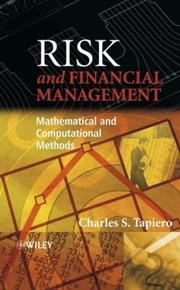
ISBN: 0470849088 Year: 2004 Publisher: Chichester : John Wiley,
Abstract | Keywords | Export | Availability | Bookmark
 Loading...
Loading...Choose an application
- Reference Manager
- EndNote
- RefWorks (Direct export to RefWorks)
Finance --- Risk management --- Finances --- Gestion du risque --- Mathematical models --- Modèles mathématiques --- Modèles mathématiques --- Insurance --- Management
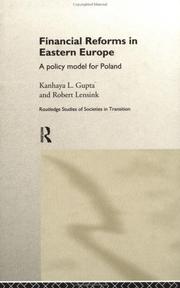
ISBN: 0415166683 9786610506514 1280506512 0203022920 9780203022924 9780415166683 9781134706624 1134706626 9781134706570 113470657X 9781134706617 1134706618 Year: 1998 Volume: 6 Publisher: London ; New York : Routledge,
Abstract | Keywords | Export | Availability | Bookmark
 Loading...
Loading...Choose an application
- Reference Manager
- EndNote
- RefWorks (Direct export to RefWorks)
This book presents a model which simulates the effects of financial reforms in transitional economies, which is then applied to Poland for a variety of policy simulations. The authors develop models for households, commercial banks and firms, expanding their enquiry into the government sector, the central banking sector, the external sector and finally the supply side. These sub-sector models explicitly incorporate institutional features specific to the Polish economy. The estimated model is used to simulate the effects of a wide array of financial policies introduced in Poland, and these resu
Finance --- Finances --- Mathematical models --- Modèles mathématiques --- Mathematical models. --- Modèles mathématiques --- Funding --- Funds --- Economics --- Currency question
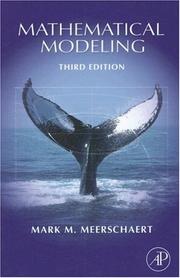
ISBN: 9780123708571 0123708575 Year: 2007 Publisher: Amsterdam Academic Press
Abstract | Keywords | Export | Availability | Bookmark
 Loading...
Loading...Choose an application
- Reference Manager
- EndNote
- RefWorks (Direct export to RefWorks)
Book
ISBN: 9780521173001 9781107001695 1107001692 0521173000 9781139026130 1139569848 1283637634 1107254124 1139572504 1139568949 1139026135 1139570757 131608924X 1139579339 9781139570756 9781139568944 9781139572507 6613950092 9786613950093 9781283637633 Year: 2013 Publisher: Cambridge Cambridge University Press
Abstract | Keywords | Export | Availability | Bookmark
 Loading...
Loading...Choose an application
- Reference Manager
- EndNote
- RefWorks (Direct export to RefWorks)
The Black-Scholes option pricing model is the first and by far the best-known continuous-time mathematical model used in mathematical finance. Here, it provides a sufficiently complex, yet tractable, testbed for exploring the basic methodology of option pricing. The discussion of extended markets, the careful attention paid to the requirements for admissible trading strategies, the development of pricing formulae for many widely traded instruments and the additional complications offered by multi-stock models will appeal to a wide class of instructors. Students, practitioners and researchers alike will benefit from the book's rigorous, but unfussy, approach to technical issues. It highlights potential pitfalls, gives clear motivation for results and techniques and includes carefully chosen examples and exercises, all of which make it suitable for self-study.
Options (Finance) --- Options (Finances) --- Prices --- Mathematical models --- Prix --- Modèles mathématiques --- Mathematical Sciences --- Probability --- Investments --- Mathematical models.
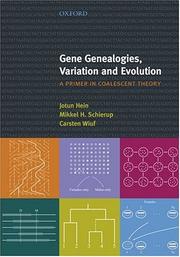
ISBN: 1280758988 0191546151 1423770803 9781423770800 9786610758982 6610758980 0198529961 9780198529958 0198529953 9780198529965 Year: 2004 Publisher: Oxford : Oxford University Press,
Abstract | Keywords | Export | Availability | Bookmark
 Loading...
Loading...Choose an application
- Reference Manager
- EndNote
- RefWorks (Direct export to RefWorks)
Authored by leading experts, this seminal text presents a straightforward and elementary account of coalescent theory, which is a central concept in the study of genetic sequence variation observed in a population. Rich in examples and illustrations it is ideal for a graduate course in statistics, population, molecular and medical genetics, bioscience and medicine, and for students studying the evolution of human population and disease.
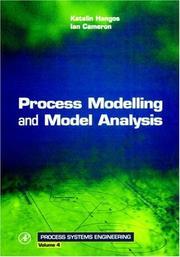
ISBN: 9780080514925 0080514928 9780121569310 0121569314 1281054135 9786611054137 Year: 2001 Publisher: San Diego : Academic Press,
Abstract | Keywords | Export | Availability | Bookmark
 Loading...
Loading...Choose an application
- Reference Manager
- EndNote
- RefWorks (Direct export to RefWorks)
This book describes the use of models in process engineering. Process engineering is all about manufacturing--of just about anything! To manage processing and manufacturing systematically, the engineer has to bring together many different techniques and analyses of the interaction between various aspects of the process. For example, process engineers would apply models to perform feasibility analyses of novel process designs, assess environmental impact, and detect potential hazards or accidents.To manage complex systems and enable process design, the behavior of systems is reduced to
Mathematical models --- Computer simulation --- Modèles mathématiques. --- Simulation par ordinateur. --- Modèles mathématiques. --- Chemical processes --- Mathematical models. --- Computer simulation.
Book
ISBN: 1527514803 9781527514805 1527505626 9781527505629 Year: 2018 Publisher: Newcastle upon Tyne, UK : Cambridge Scholars Publishing,
Abstract | Keywords | Export | Availability | Bookmark
 Loading...
Loading...Choose an application
- Reference Manager
- EndNote
- RefWorks (Direct export to RefWorks)
Stellar dynamics is an interdisciplinary field where mathematics, statistics, physics, and astronomy overlap. The approaches to studying a stellar system include dealing with the collisionless Boltzmann equation, the Chandrasekhar equations, and stellar hydrodynamic equations, which are comparable to the equations of motion of a compressible viscous fluid. Their equivalence gives rise to the closure problem, connected with the higher-order moments of the stellar velocity distribution, which is explained and solved for maximum entropy distributions and for any velocity distribution function, depending on a polynomial function in the velocity variables. On the other hand, the Milky Way kinematics in the solar neighbourhood needs to be described as a mixture distribution accounting for the stellar populations composing the Galactic components. As such, the book offers a statistical study, according to the moments and cumulants of a population mixture, and a dynamical approach, according to a superposition of Chandrasekhar stellar systems, connected with the potential function and the symmetries of the model.
Galactic dynamics. --- Stellar dynamics. --- Computer simulation. --- Mathematical models. --- Dynamique stellaire. --- Simulation par ordinateur. --- Modèles mathématiques.
| Listing 1 - 10 of 187 | << page >> |
Sort by
|

 Search
Search Feedback
Feedback About UniCat
About UniCat  Help
Help News
News